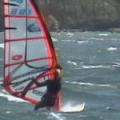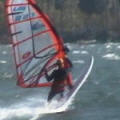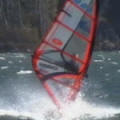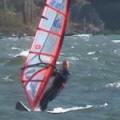Vulcan
The Vulcan, also known as the Air-Jibe, is one of the most direct ways to make the transition from one direction to the other. This is usually the first advanced move a freestyle sailor learns and is unquestionably the progenitor of almost all the new-school maneuvers including the Spock, Diablo, and Grubby. Learning this maneuver provides the ground work for the genre of moves which basically involves learning the skill to use the scoop in the front part of the board as a means to land, slide, and rotate the board in a variety of ways. You will need good board popping skills, fast hands for the sailwork, switch stance capability, and enough body awareness to stay over the center of the board during the landing.
With respect to windsurfing history, Chris Wyman is the first sailor to bust the move and Josh Stone took the move and extended it into the Spock.












Rider: Royn Bartholdi
Steps
 1)
Look for some chop slightly upwind. On flatter water, head across the wind or slightly off the wind. Unhook and (this is very important) slide the front hand way forward on the boom toward the boom head. Speed is generally your friend so charge like Madd-Maxx into this move. If you're uncomfortable with the speed then head upwind a little to kill the wind.
1)
Look for some chop slightly upwind. On flatter water, head across the wind or slightly off the wind. Unhook and (this is very important) slide the front hand way forward on the boom toward the boom head. Speed is generally your friend so charge like Madd-Maxx into this move. If you're uncomfortable with the speed then head upwind a little to kill the wind.  2)
Crouch your body down while also leaning slightly forward so you can explode off the water. This is an aggressive move so Jump really hard by pushing down with the back foot and lifting the front foot and front arm up to the sky. Remember to jump off your toes like when you jump rope and to keep your body centered and close to the mast. On flat water you will even have to jump harder. Initially Sheet-in the sail on the jump so you have enough power and lift to jump the board around. Your eyes are best focused somewhere near the mast foot.
2)
Crouch your body down while also leaning slightly forward so you can explode off the water. This is an aggressive move so Jump really hard by pushing down with the back foot and lifting the front foot and front arm up to the sky. Remember to jump off your toes like when you jump rope and to keep your body centered and close to the mast. On flat water you will even have to jump harder. Initially Sheet-in the sail on the jump so you have enough power and lift to jump the board around. Your eyes are best focused somewhere near the mast foot.  3)
This is the most important part of the move and must be integrated seemlesssly with the previous step: Pull the heel of the back foot up toward your buttocks so the board is completely out of the water while simultaneously releasing the back hand and swinging the rear shoulder (so you body opens up to the new direction).Look back in the other direction, or, as I prefer, look down at the board to the area just in front of the mast base.
3)
This is the most important part of the move and must be integrated seemlesssly with the previous step: Pull the heel of the back foot up toward your buttocks so the board is completely out of the water while simultaneously releasing the back hand and swinging the rear shoulder (so you body opens up to the new direction).Look back in the other direction, or, as I prefer, look down at the board to the area just in front of the mast base.  4)
Reach the open hand toward the other side of the boom and pull the mast toward your body, across the wind. Try to make the hand movement super fast. Look in the other direction, or, as I prefer, focus your eyes down and vertical over the water so your body weight is centered properly to land on the front section of the board. You are jumping in a way so your body is positioned over the center of the board.
4)
Reach the open hand toward the other side of the boom and pull the mast toward your body, across the wind. Try to make the hand movement super fast. Look in the other direction, or, as I prefer, focus your eyes down and vertical over the water so your body weight is centered properly to land on the front section of the board. You are jumping in a way so your body is positioned over the center of the board.  5)
Grab the other side of the boom with the open hand. Notice your arms will cross here.Kick your legs behind you while leaning your body slightly forward over the nose of the board. Focus your eyes down on the front part of the board deck, just in front of the mast base. Notice my weight is over my front leg and my back leg is extended like a brace with the toes down. Also, the nose of the board is on the water and sliding backward. The nose lands first. Some sailors like to Swivel (twist) the body up and around the mast.
5)
Grab the other side of the boom with the open hand. Notice your arms will cross here.Kick your legs behind you while leaning your body slightly forward over the nose of the board. Focus your eyes down on the front part of the board deck, just in front of the mast base. Notice my weight is over my front leg and my back leg is extended like a brace with the toes down. Also, the nose of the board is on the water and sliding backward. The nose lands first. Some sailors like to Swivel (twist) the body up and around the mast.  6)
Maintain your body weight over the board by leaning slightly forward over the center of the board and a little on your toes. In other words, your weight is over your front foot. This keeps the board's tail and rails clear of the water, so you can maintain a slide. Your body remains somewhat twisted. Remember to stay close to the mast.
6)
Maintain your body weight over the board by leaning slightly forward over the center of the board and a little on your toes. In other words, your weight is over your front foot. This keeps the board's tail and rails clear of the water, so you can maintain a slide. Your body remains somewhat twisted. Remember to stay close to the mast.  7)
Let go of the trailing hand and lean the mast windward. Your weight is still forward so the tail stays out of the water and the board slides backward because the back rails do not catch the water.
7)
Let go of the trailing hand and lean the mast windward. Your weight is still forward so the tail stays out of the water and the board slides backward because the back rails do not catch the water.  8)
Reach back and grab the boom as fast as you can while still leaning the mast windward. Notice my body stays erect and centered over the board.
8)
Reach back and grab the boom as fast as you can while still leaning the mast windward. Notice my body stays erect and centered over the board.  9)
Sheet in very hard to lock in the sail and regain the board-body-sail connection. You also must shift your weight windward so you have now regained any lost stability. The key to gaining stability in a Vulcan is to get to this position quickly.
9)
Sheet in very hard to lock in the sail and regain the board-body-sail connection. You also must shift your weight windward so you have now regained any lost stability. The key to gaining stability in a Vulcan is to get to this position quickly.  10)
Let the board slide to a stop.
10)
Let the board slide to a stop.
 11)
Start sailing switch-stance until you feel like you have control. The trick to sailing switch stance is to keep the body twisted with the sail sheeted-in and your body weight windward. Slowly bear off wind.
11)
Start sailing switch-stance until you feel like you have control. The trick to sailing switch stance is to keep the body twisted with the sail sheeted-in and your body weight windward. Slowly bear off wind.
 12)
Now lean on the front foot a bit and push the heel of your back foot down and out away from the strap. This is tricky to learn at first because the natural tendency is to pull up with the back foot -- not! Switch your feet to a regular stance. Live long and prosper my Vulcan brother.
12)
Now lean on the front foot a bit and push the heel of your back foot down and out away from the strap. This is tricky to learn at first because the natural tendency is to pull up with the back foot -- not! Switch your feet to a regular stance. Live long and prosper my Vulcan brother.
Videos
Loading the player ...
I performed this Vulcan under powered with a landing that was short. In other words, I did not get fully around but was still able to pull off the move. The key points are to slide the front hand forward toward the mast, perform a good jump, turn your head in the other direction, and pull the mast across the body during the landing. You can save a poor execution by getting the hands on the boom quickly and regaining the connection between you, the sail, and your board.
Tips
Ideas
All Contents Copyright © 2008-2025 Royn Bartholdi. All Rights Reserved